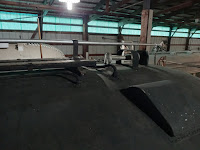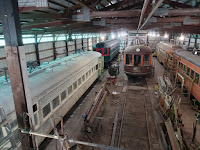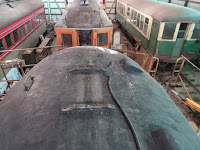As promised, the next big project will be replacing the roof on CA&E 460 (not to be confused with CSL 460!) It's now in the roof booth, as shown recently by Frank. And this gives us a good opportunity to start with a visual inspection of the status of the roof. From the ground it may not be obvious that anything is wrong. We'll start at the #1 end, which is east.
Aha, I see that vandals have already been at work, ripping back parts of the canvas. Well, I guess that fixes it -- now I have no choice but to go ahead and rip it all off. Shucks.
There are two layers of canvas on this car, and I'll talk more about that later. Anyway, this is the #1 end, and it is relatively good. There are occasional places where patching has taken place.
But at the #2 end, the trolley pole was removed at Cleveland, and a pantograph installed so the 460 could run on the Greater Cleveland RTA. That didn't work very well, and when the car arrived at IRM in 2010, new trolley boards were installed in a hurry so the car could be operated. You can see that they have warped, and need to be replaced. You can also see some of the little wooden supports for the pantograph.
This is also the end where there was hole punched in the roof at Trolleyville. I patched this hole up back in 2016, but I will want to recheck it now that we're replacing all the canvas.
And here are the fuse box and lightning arrestor, both rather worn.
Underneath the canvas, the roof structure looks quite good... so far.
So I started removing all the apparatus from the roof. Pete helped me lock down the bases, so I could remove the poles. They were then carefully stored in the scaffolding.
After a couple of hours of work, I had removed the poles, the bases, the horns, the fuse box and arrestor.
Here we see a view of the trolley boards with everything removed. Fritz and Lorne later helped me carefully lift the bases down off the roof, onto the platform.
For most of the day, Pete and Fritz were working on painting various parts of the 160. And Lorne was working on the PCC truck in the Lean-3.
After a couple more hours, the trolley boards are gone at the west end of the car, along with the annoying little wedges for the pantograph support. There are two ventilators at this end because there's a washroom, which the 451 and 453 lacked.
By the way, at the other end there's now a gap, and we may notice that the 714 is over the pit for inspection.
Then I continued by removing the horn guards and baffles.
Then we can remove some more canvas. Tearing it off is pretty easy, getting rid of it all is the hard part. The lower (original) layer is pretty brittle and rips apart easily, but in many places it's either tacked down or melted onto the wood, so that makes it harder to remove. The outer layer is not fastened down except at the tack moldings, but it's much harder to rip apart. Anyway, this is a good outlet for one's anger and frustration, for a limited time only.
I think the tack molding will be in good enough condition to be fortified with epoxy and reused, but we'll see as we go along. For the first day's work, this went pretty well.
Finally, I noticed that there were a couple of contractors working on the roof of the North Western building, so progress has evidently resumed.
And of course there were several other things going on at IRM. There always are!



















1 comment:
I still chuckle at past discussions of roofs getting "Trolleyvilled." Fortunately, IRM has quality operating practices....
-T. Rich
Post a Comment